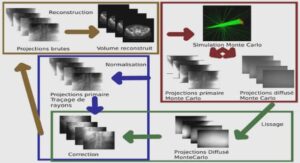Description of the a-Si material
Silicon in its amorphous state (a-Si) was first obtained by Bertzelius at the beginning of the 19th century [1], but until the 1960s it was not used as a semiconductor. Amorphous silicon without hydrogen was prepared in those days by thermal evaporation or sputtering [2]. This unhydrogenated material was highly defective, which inhibited its use as a useful semiconductor.
In 1965 it was discovered that deposition of amorphous silicon employing glow discharge as the deposition technique yielded a material with much more useful electronic properties [3,4]. Some years later, Fritsche and co-workers in Chicago confirmed that a-Si produced from a glow discharge of SiH4 contains hydrogen [5,6]. In 1975 a boost in research activities occurred when it was shown that hydrogenated amorphous silicon (a-Si:H) could be n- or ptype doped by introducing phosphine (PH3) or diborane (B2H6) in the plasma [7]: a variation of resistivity of more than 10 orders of magnitude could be reached by adding small amounts of these dopants.
This discovery immediately initiated the research on practical amorphous silicon devices. Carlson and Wronski at RCA Laboratories started in 1976 with the development of photovoltaic devices [8]. The first p-i-n junction type solar cell was reported by the group of Hamakawa [9,10]. In 1980, Sanyo was the first to fabricate market devices: solar cells for hand-held calculators [11]. Application of a-Si:H in field effect transistors [12-14] is based on the capability to deposit and process a-Si:H over large areas. Combining the photoconductive properties and the switching capabilities of a-Si:H has yielded many applications in the field of linear sensor arrays, e.g. 2D image sensors, position-sensitive detectors of charged particles, X rays, gamma rays, and neutrons [15-18].
Atomic structure
The disorder of the atomic structure is the main feature which distinguishes amorphous from crystalline materials. Hydrogenated amorphous silicon is a disordered semiconductor whose optoelectronic properties are governed by the large number of defects present in its atomic structure. The amorphous nature arises from the absence of long-range order in the lattice of the material. The first few nearest neighbor distances are separately distinguished, but the correlation between atom pairs disappears after a few interatomic spacings [19]. One can describe the disorder by the atom pair distribution function, which is the probability of finding an atom at a distance r from another atom. A perfect crystal is completely ordered to large pair distances, while an amorphous material only shows short-range order. Because of the short-range order, material properties of amorphous semiconductors are similar to their crystalline counterparts. The covalent bonds between the silicon atoms in a-Si:H are similar to the bonds in crystalline silicon.
In the ideal CRN model for amorphous silicon, each atom is fourfold coordinated, with bond lengths similar (within 1 % [22]) to that in the crystal. In this respect, the short range order (< 2 nm) of the amorphous phase is similar to that of the crystalline phase. Amorphous silicon lacks long-range order because the bond-angles deviate from the tetrahedral value.
The continuous random network may contain defects, but the concepts of interstitials or vacancies applicable for crystalline materials are not valid here. Instead, in the CRN one uses the coordination defect when an atom has too few or too many bonds. In a-Si:H, dangling bonds arise when a silicon atom has too few bonds to satisfy its outer sp3 orbital. It is the common view that the dominant defect in amorphous silicon is a threefold-coordinated silicon atom. This structural defect has an unpaired electron in a non-bonding orbital, called a dangling bond. Pure amorphous silicon has a high defect density of the order of 10²⁰ cm⁻³ , which prevents photoconductance and doping. The special role of hydrogen with regard to amorphous silicon is its ability to passivate defects by providing for electrons to the dangling bonds. Hydrogenation to a level of ~ 10 at.% reduces the defect density by four to five orders of magnitude.
Electronic structure and properties
The structural disorder influences the electronic properties in several different ways. The similarity of the covalent silicon bonds in crystalline and amorphous silicon leads to a similar overall electronic structure – amorphous and crystalline phases of the same material tend to have comparable band gaps. The disorder represented by deviations in the bond lengths and bond angles broadens the electron distribution of states and causes electron and hole localization as well as strong scattering of the carriers. Structural defects such as broken bonds have corresponding electronic states which lie in the band gap. There are also phenomena which follow from the emphasis on the local chemical bonds rather than the long range translational symmetry. The possibility of alternative bonding configurations of each atom leads to a strong interaction between the electronic and structural states and causes the phenomenon of metastability.
One of the fundamental properties of a semiconductor or insulator is the presence of a band gap separating the occupied valence band from the empty conduction band states. Since according to the free electron theory, the band gap is a consequence of the periodicity of the crystalline lattice, in the past there were considerable debates over the reason that amorphous semiconductors had a band gap at all. It was stated by Weaire and Thorpe [23] that the bands are most strongly influenced by the short range order, which is the same in amorphous and crystalline silicon and the absence of periodicity is a small perturbation.
The preservation of the short-range order results in a similar electronic structure of the amorphous material compared to the crystalline one: bands of extended mobile states are formed (defined by the conduction and valence band edges, EC and EV) separated by the energy gap, Eg, more appropriately termed « mobility gap ». The long-range atomic disorder broadens the densities of energy states, resulting in band tails of localized states that may extend deep into the band gap. Coordination defects (dangling bonds) result in electronic states deep in the band gap, around mid-gap. As electronic transport mostly occurs at the band edges, the band tails greatly determine the electronic transport properties. The deep defect states determine electronic properties by controlling trapping and recombination.
1 a-Si:H and its applications |





